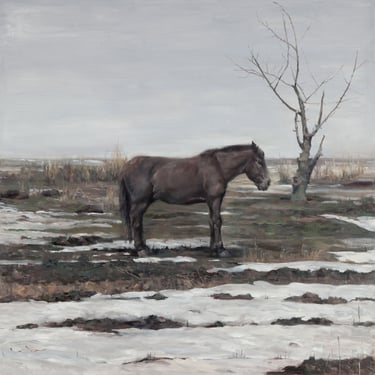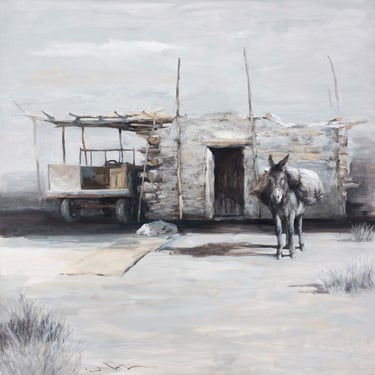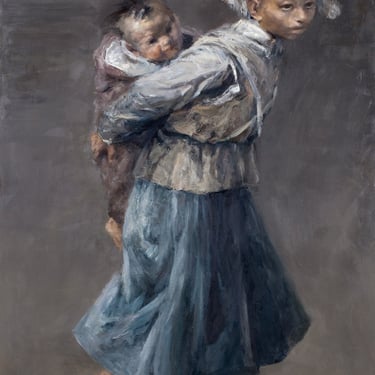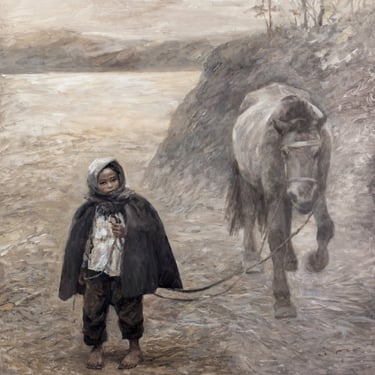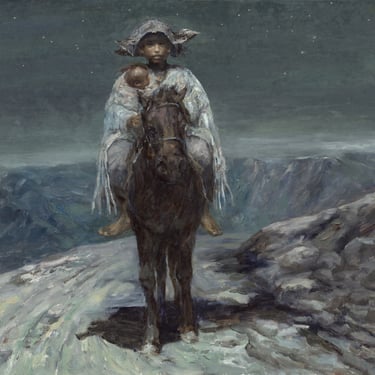Loneliness, Stillness, Tranquility
Author | Metra Lin
10/1/2014
How I feel about Cen Long's Art
More than a decade ago, I was profoundly moved when I first saw Afar, a painting created by Cen Long in 1990. The beauty of Afar lies in its poetic stillness, seemingly suspended in the air. The purity of the soul ascends with the back silhouette of the figure, and through the Mongolian girl’s retreating form, I could perceive the vastness of the universe beyond—boundless, sacred, and imbued with a divine beauty. In that tranquil moment, there was no superfluous noise—only the sound of solitude accompanying the soul’s solitary journey.
This sense of loneliness is a defining feature of Cen Long’s art, which is why many viewers often detect a melancholic undertone in his works. Indeed, his paintings seem to carry a faint sorrow, yet it is a sorrow that, paradoxically, draws my soul into a dimension both ordinary and profoundly moving, where the deepest strings of my heart are touched. I have always felt that this kind of beauty is enduring—it resonates with the sealed depths of the soul. It is for this reason that I am deeply touched by Cen Long’s artistry and hold his aesthetic philosophy in high regard. A few years ago, we became close collaborators, united by our shared devotion to beauty.
His recent work, Frozen Moment, feels like an extension of Afar—the composition is even more refined, the silence more profound, as if time itself has come to a standstill. With a minimalist approach, he has stripped away unnecessary environmental details, leaving behind a purity so intense that one can almost hear the sound of a falling needle. The chaotic world seems to have no bearing on the artist’s vision; rather, I see this as his attempt to purify the soul. Standing before this painting, one cannot help but remove the masks of daily life and turn inward for self-examination, immersing oneself in the scene to experience its kindness and tranquility.
In Melting Snow, a horse, momentarily freed from labor during the winter’s rest, stands alone on the thawing earth. It is solitary, yet utterly at peace, as if it can feel the gentle caress of nature and the divine. Its quiet acceptance of a life spent trading freedom and toil for mere survival stirs a deep sense of contemplation. Much like Frozen Moment, this piece invites viewers to appreciate not only Cen Long’s masterful technique and elegance but also the deeper spiritual realm his works evoke—a realm where the soul finds purification. Perhaps this is what critics mean when they say his art possesses "a sublimation that borders on the religious."
This spiritual sentiment is also evident in his other works, particularly in Starry Sky and Blue Bird. Themes of motherly love and familial affection resonate deeply, touching the hearts of viewers. What is conveyed is not merely the figures within the paintings but the immense love they embody—a love that transcends the personal, expanding into something universal and boundless. In the face of the vast cosmos, humanity may seem small, but in this love, it is rendered sacred. The mothers and sisters depicted in his works possess a solemn, almost Madonna-like grace, their presence imbued with reverence and grandeur.
Cuckoo’s Call captures such a moment: the early morning mist has yet to lift, and a child leads a horse, preparing to help the adults plow the land. The cries of cuckoos echo through the hills, urging people to start their labor. The child, clad in thin clothing, walks on, searching beyond the frame for the unseen bird. Winter has passed, and spring is near. With this painting, the artist invites viewers to join him in a silent prayer for a warm spring for the children. Through the emotions and inner worlds of his figures, Cen Long continuously explores the innate purity and kindness of human nature. This pursuit of untainted essence is his artistic sanctuary—a deeply personal, almost primordial spirituality unique to him.
I believe Cen Long’s works do not conform to classical realism, nor do they fit neatly into the category of contemporary art. He is simply himself—an artist who stands apart in the modern era. And that, I believe, is precisely what makes him so invaluable.
